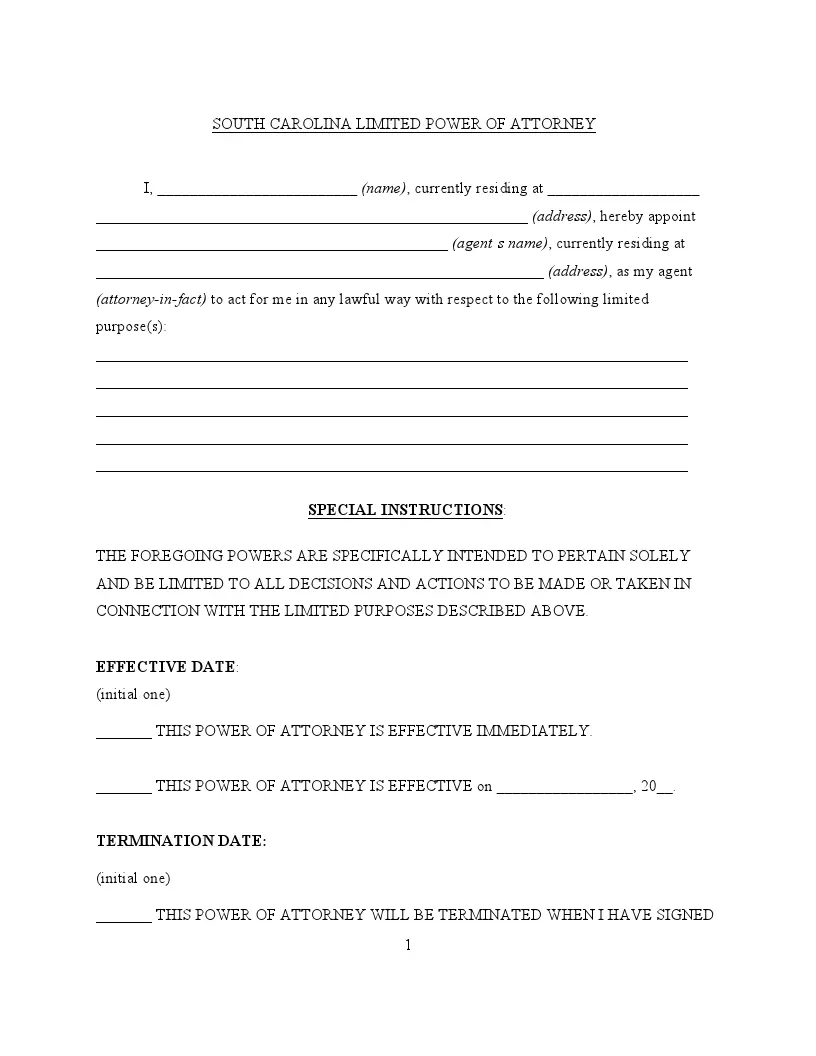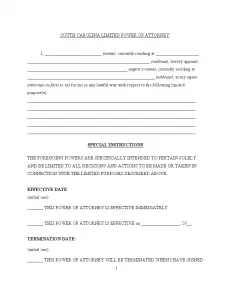South Carolina Limited Power of Attorney Form
The South Carolina limited power of attorney is a legal document that allows a person (known as the “principal”) to grant specific powers to another person (called the “agent” or “attorney-in-fact”) to act on their behalf. Whereas a general power of attorney covers a broad range of actions, a limited power of attorney is narrowly tailored to specific tasks or situations. These tasks could be as narrow as handling a particular transaction or as broad as managing all financial affairs, but only during a specified period.
The limited power of attorney needs to be written, outlining the precise powers of the agent. This document is especially handy in South Carolina when the principal cannot carry out specific tasks in person.
You fill out other South Carolina power of attorney forms to legally appoint someone to manage your affairs in the state.

Build Your Document
Answer a few simple questions to make your document in minutes
Save and Print
Save progress and finish on any device, download and print anytime
Sign and Use
Your valid, lawyer-approved document is ready
The laws surrounding signing a limited power of attorney in this state are laid out under the South Carolina Code of Laws, Title 62, Article 8. This legislation defines an “agent” as someone authorized to act on behalf of a principal, with duties that could range from financial decisions to legal actions. Other important points include:
- The agent must strictly adhere to the powers specifically granted in the power of attorney document.
- A fiduciary relationship is established, meaning the agent is expected to act in the principal’s best interest.
According to Section 62-8-105 of the South Carolina Code of Laws, the document must be signed in the presence of a notary. Additionally, two credible witnesses must be present to sign, ensuring further validation and adherence to legal standards.
South Carolina Limited Power of Attorney Form Details
| Document Name | South Carolina Limited Power of Attorney Form |
| Other Name | South Carolina Special Power of Attorney |
| Relevant Laws | South Carolina Code of Laws, Title 62, Article 8 |
| Avg. Time to Fill Out | 8 minutes |
| # of Fillable Fields | 32 |
| Available Formats | Adobe PDF |
Filling Out South Carolina Limited POA
Following these steps, you can properly fill out a limited power of attorney form in South Carolina, ensuring your agent has the legal authority to act on your behalf according to your instructions.
1. Identify the Principal and Agent
Begin by entering your full name and residential address under the section marked “principal.” Follow this by filling in the name and address of the person you appoint as your agent or attorney-in-fact.
2. Define the Powers Granted
Specify the exact powers you are granting to your agent. This should align with the tasks or decisions they are authorized to handle. Be concise and clear to avoid any ambiguity about the extent of authority given.
3. Set the Effective Date
Choose when the powers will become effective. If the limited power of attorney should start immediately, initial the corresponding option. Alternatively, if it should begin on a specific future date, initial that option and provide the date.
4. Decide on Termination Conditions
Determine how and when the limited power of attorney will end. Options typically include termination on a specific date, upon incapacitation, or through your signed revocation. Initial the condition best suits your needs and fill in any necessary dates.
5. Appoint a Successor Agent
If there is a possibility that the primary agent might not be able to serve or continue serving, you can appoint a successor. Fill in the name and address of the successor agent who would take over under such circumstances.
6. Sign and Date the Form
After reviewing the document for accuracy and completeness, sign and date the form in the designated areas. Ensure that your printed name is also clearly written below your signature.
7. Complete Notarization
The final step involves the notarization of the document. This should be done in the presence of a notary public who will verify your identity and witness your signature. The notary will then complete the acknowledgment section, affirming that you understand and consent to the contents of the limited power of attorney.
